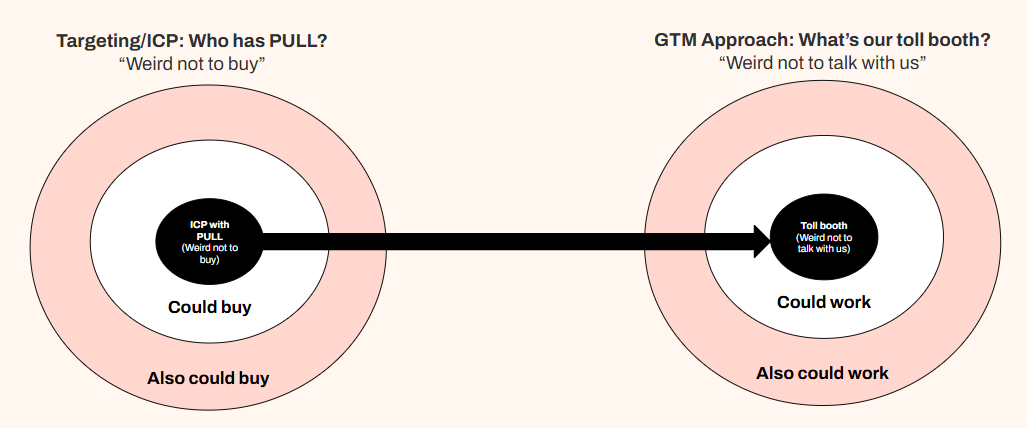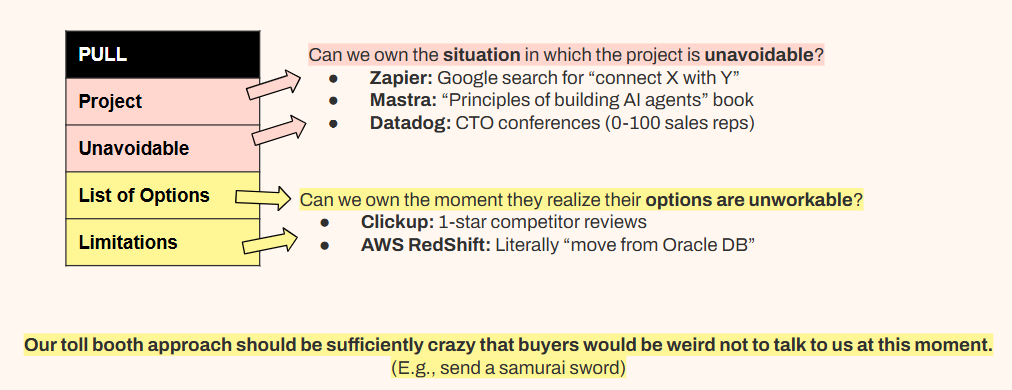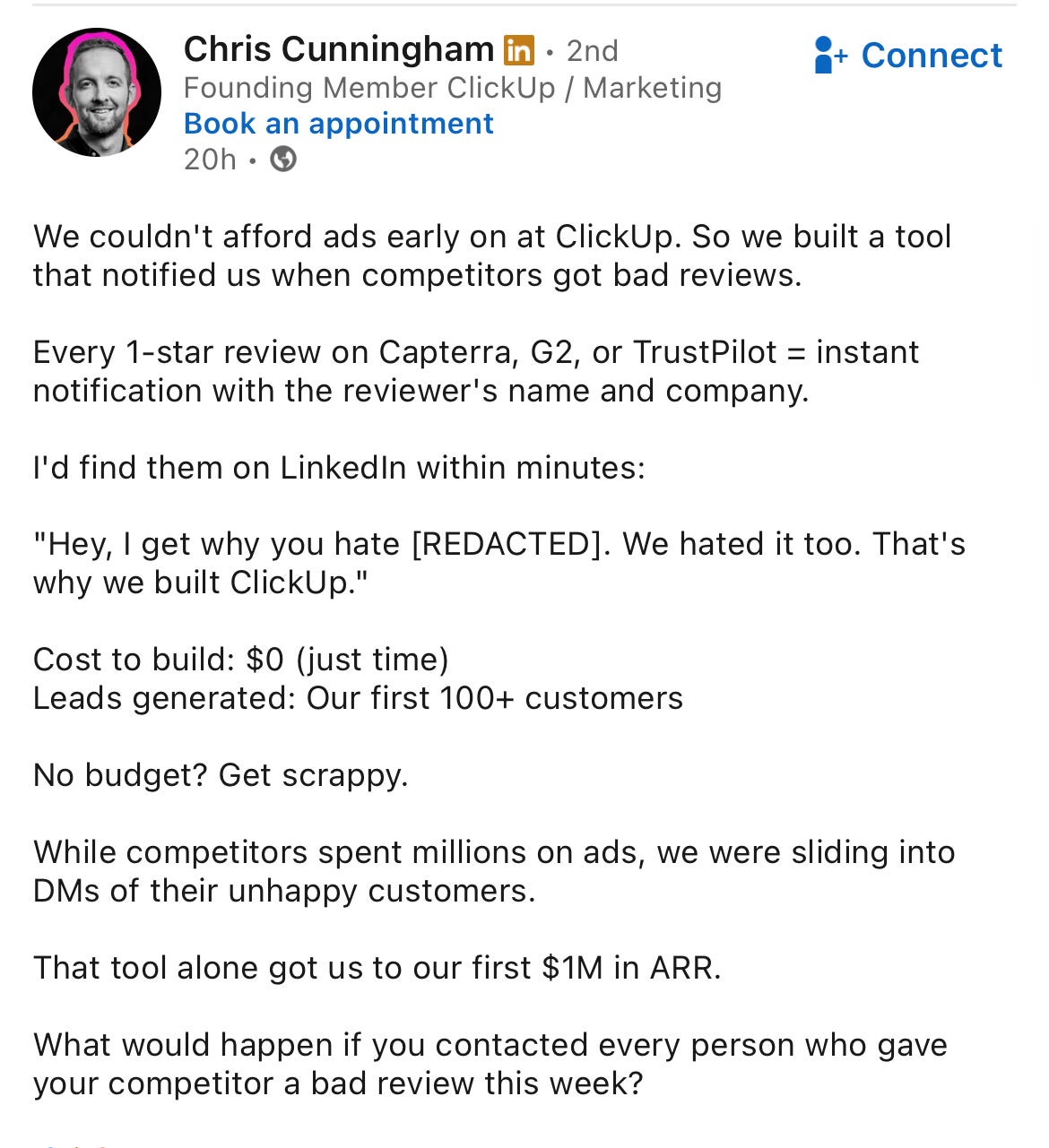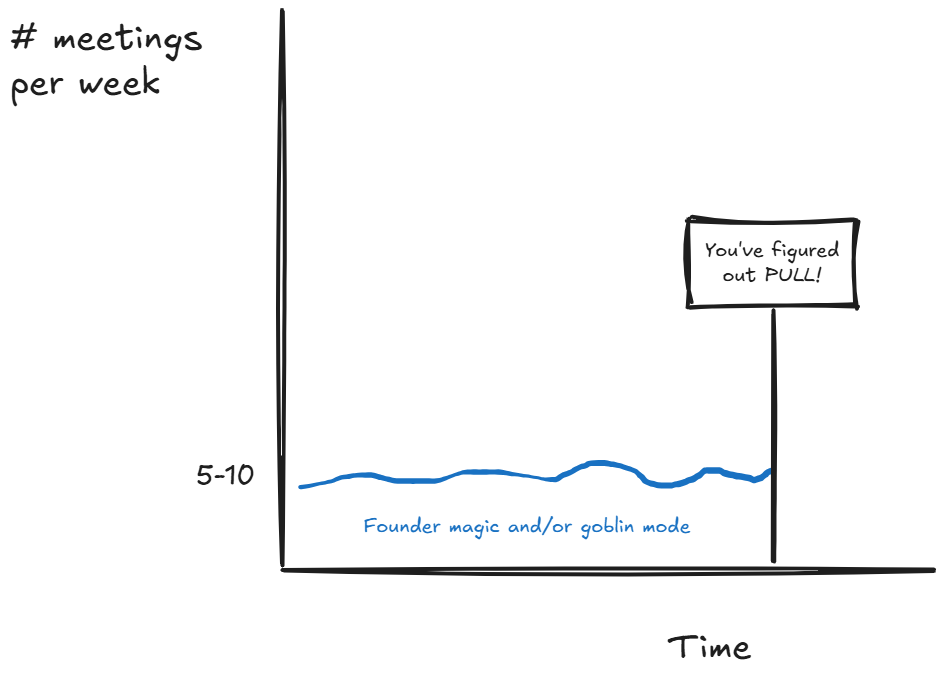Pipeline mega-post
Pre-PMF, post-PMF, theory and practice
PSA: There’s a companion podcast! I go into WAY more detail on the “Physics of Startups” podcast - available on Spotify, YouTube, & Apple Podcasts. Here’s this episode link:
Someday, I will never have to talk about pipeline again. That day is not today.
Here’s why: Founders often come to me in product-market fit existential crisis mode, and it turns out they speak to maybe 1-2 potential customers per week, which means their crisis is pipeline, not PMF! You haven’t earned your existential PMF crisis yet!
I have created two approaches to pipeline and written about them (“Founder Magic” + “Toll Booth”), but I still find that smart founders still mix these concepts up, and wind up doing outbound that doesn’t, and can’t, work. This is on me! My hope is that this mega-post gives you the intuition around PULL-based pipeline approaches so you don’t have to worry about pipeline again, and, selfishly, so that I can stop writing about pipeline.
But first, a PSA: Early on, you need to schedule 1-2 meetings with potential customers per day (5-10 per week). Expect to spend 2-3 hours per day (ideally, the first 2-3 hours of your workday) trying to schedule your 1-2 meetings. Most early-stage founders spend almost no time scheduling meetings and wonder why they don’t have any pipeline.
This is the job. This is always the job, as my friend Rebecca from Tabs has found even post-Series B:
If this doesn’t excite you, it’s time to become the Sales Founder.
Approach 1: Founder Magic (“Be Weird”)
Founder Magic is the approach you probably used to schedule loads of semi-useful discovery conversations before you had a product. It is the approach that essentially says, “Hey, I’m an interesting founder working on something you might have thoughts about, will you talk to me?” Or even, “Hey we’re a cool startup looking for advisors, thought you might be a fit, down to chat?”
If we get to the essence of this message, it is, “I’m cool, you’re cool, let’s talk!”
The point of this approach is that it gets you into conversations with potential customers by simply pitching that it will be cool for them to talk to you - because you have no clue what else to pitch that will guarantee people will talk to you. In other words, you don’t know what PULL is and who has it.
Said differently: You have a PULL hypothesis, but there’s a large chance it’s somewhat wrong, and you can only find out in which ways it is wrong by having sales conversations. But, you can’t schedule sales conversations pitching a PULL hypothesis that’s somewhat wrong. This is a circularity that can keep you stuck forever.
Here’s the way out: The only thing you have going for you is that you’re cool and interesting; the only thing that works in messaging is seeming interesting enough that they would be weird *not* to talk to you.
This is what nobody tells you: Tons of fast-growing startups started with founder magic. Many Series B+ founders whisper to me that their first customers came this way, as if they are embarrassed by it, or as if it is wrong. They will almost never admit this publicly.
I get the stigma. It feels weird, especially when you think of this as a “bait-and-switch” - where you’re getting someone on a call under false pretenses to pitch them a product. But if you think this way, it’s just because you have sales backwards in your brain, you think selling means “convince people to buy your product” - when the opposite is true: If they have demand, they will make it a sales call. (See “Physics of Sales, Part 1 + Part 2”; “There is no such thing as a sales call”)
The second objection people have to Founder Magic: “We’re going to get a lot of meetings with people who don’t have demand, and this will waste our time!” Well, yeah, but when you’re doing founder magic, you don’t know exactly what demand IS; the point of this is to figure out exactly what demand is and who has it. When you figure this out, you can either turn founder magic OFF because you’ve proven a toll-booth strategy… or you can keep using the messaging that works, but refine your targeting to only reach out to people WITH DEMAND.
How, then, do you do founder magic well?
Good Examples:
“Hey - I’m a second-time founder building a weird kind of AI software engineer, wanted to get your take, down to chat?”
“Hi! I’m an MIT PhD building a startup focused on AI in healthcare marketing - saw your background and would love to explore getting you involved in some way (advisor, investor, partner). Open to connect in the coming weeks?”
“Hey - Mark Cuban from Shark Tank just invested in us and I thought you might find it interesting too, we’re doing X, open to an intro conversation?”
Bad Example:
“Hi [name], you have an impressive background! I am the founder of Acme Co, working on the future of agentic workflows. We are working with leaders in the space who have significant pain points around their manual processes, and have been able to prove significant ROI. Would you be willing to give your feedback?”
Why this won’t work:
You’d never say these words to another human
Nothing about it is interesting to them
It’s in the “uncanny valley” between a founder magic email and a traditional sales email, taking the worst of both worlds
Constructing your message:
Find your magic - what is your unfair advantage that your potential customers will find interesting? What is so cool or weird about you in the eyes of potential customers… that they would be crazy not to meet with you?
Sometimes it’s that you are a YC startup… but not if your potential customers don’t know what YC is or what a “founder” is (I have seen this frequently)
Maybe you’re giving a keynote speech somewhere interesting and relevant!
It might have nothing to do with being a founder - maybe you’re an expert in something random and interesting!
Note that eventually this will be your value prop, or a customer case study, or something more salesy - the rule is always the same: What can you send such that a potential customer would be weird not to talk with you?
Your V1 of founder magic might not work - perhaps it’s your message, perhaps it’s your LI/X profile (if you’re doing this via DMs); get a founder friend to look at it. Or, better, get a potential customer to look at it. Iterate every 1-2 weeks until you’re getting 5-10+ meetings per week with founder magic.
Approach 1a: Founder Magic Hacks
There are a few ways I’ve seen founders hack “founder magic” that you should know about:
Good hack: Bringing on a group of well-connected advisors to make warm intros. Advisors get some dollar value in equity (e.g., $5k / $10k) for each intro they make that turns into a customer. I have seen many startups get to $1M+ with a pipeline sourced almost exclusively from advisor intros.
Bad hack: I have seen more than a few startups going through popular accelerators who “swap” revenue with other startups in the accelerator. This makes revenue numbers look pretty for both startups, which they use for hype and to raise from VCs who either don’t know or don’t care. You’re going to see this happening and be tempted to do it, thinking everybody else is doing it. Then you’re not going to do it.
Sometimes founder magic isn’t working and you’re not sure what to do. Maybe you’re selling to manufacturers who aren’t online; maybe you’re stuck at 2-3 meetings per week with people who are “meh”.
This is the time to go Goblin Mode.
In this situation, you say, “screw it, what crazy thing can we do to get in front of 5 of these potential customers by end of week,” and you usually wind up flying somewhere, showing up with a cake at someone’s office, and/or doing something else that the MBA part of your brain thinks is nuts and embarrassing.
“But Goblin Mode isn’t sustainable!” Maybe, maybe not. It’s certainly more sustainable than zero meetings per week.
Approach 2: Toll Booth
Once you have figured out your startup’s PULL equation, you know who, in what situation, would be weird not to buy your product.
This is your ideal customer profile, who should have a ~100% close rate, highly efficient sales cycles, and ~100% post-sale success rate. Yes, other people could buy, and could have a 10-20% close rate… but why would you focus on them when you know who would be weird not to buy?
Now that we know who would be weird not to buy, we then can ask a similar question on the GTM side: What can we do such that the people who would be weird not to buy would be weird not to talk with us?
When you figure out how to make it weird for someone with demand *not* to talk with you, you’re employing a strategy I call “the toll booth” - from the original post:
Imagine you meet a slightly defective genie, who gives you the opportunity to place a toll booth anywhere on Earth. Where are you going to place it? Are you going to place it in Siberia? Of course not! You’re going to place it at a choke point where a sh*tton of traffic HAS to pass through.
It’s a similar exercise for pipeline: When we try to figure out what our approach to pipeline should be, it’s like placing a toll booth - and we should place our toll booth wherever the thing that causes demand is.
Here’s how the toll booth fits with the PULL framework:
There are essentially two toll bootha angles to take:
Owning the situation in which the project is unavoidable.
Owning the moment they realize their options are unworkable.
They are virtually identical, one just puts the toll booth in front of competitors/alternatives, the other focuses more on the situation. ClickUp put a toll booth outside competitors to get to their first $1M ARR:
Nice.
Now, your Toll Booth might be a single master-stroke tactic (e.g., just sending a samurai sword to a list of people who have demand) or it could be a bunch of tactics that all support the Toll Booth (e.g., outbound, events, PR, etc.). Each toll booth approach is different because every startup’s PULL framework is different.
But the point is: With the toll booth, you’re taking a particular plot of real estate, and you’re taking it by force, and you’re taking it with all your effort. This is why you do this after we are confident we have found real, repeatable PULL.
Comparing, Contrasting, and WHEN
Startups are a race to figure out PULL and build your repeatable case study. Before you know what PULL is, you only have bad options for pipeline:
Founder magic
Goblin mode
Warm intros, referrals, etc.
You can, of course, try to spam-cannon tens of thousands of salesy emails, or personalize fewer salesy emails, and it might work; you can also try a toll booth approach that also might work - these scalable things rarely work until you have gone from your PULL hypothesis to demonstrated, repeatable pull with 5-10+ customers.
Which means early on, you’re scraping together 5-10+ meetings per week using the more janky methods I mentioned early on:
After you’ve found PULL, your goal is to find something called a “scalable growth lever.” Sure, this might mean building up a boiler room of SDRs and scaling sales the traditional way (or maybe with AI SDRs, who knows); I strongly recommend considering a toll booth approach for all the reasons listed above.
Usually founder magic can’t scale very far. Sometimes, when they find their growth lever, teams turn founder magic off. Most of the effort at this point is nailing the Toll Booth approach - because that can get us from 5 meetings per week to 50+ and $10M-$100M+ ARR:
I hope, hope, HOPE this covers all your pipeline related questions.
If I missed something, let me know, and I will (grudgingly) write more.
PS: I run a “product-market fit + sales” course & do 1:1 work with B2B founders to figure out 0-1 sales. If you’d like to potentially work with me in Q4, reserve time on my Calendly in the next few weeks HERE - more info about working with me is HERE.








Totally agree that limited reach out is what's causing the pipeline crisis.
If you take Alex Hormozi's rule of 100, if the top of the funnel is the problem, then you should be reaching out to 100 new leads a day. If people are only reaching out to 1 a day, then they have a 2 order of magnitude problem.
Rob, I promise never to ask about pipeline and founder magic again XD
I would like to share some of my own attempts at being weird for others - full disclosure, startup founders pay me to do cold calling and set meetings for them, and report back on what makes people not hang up the phone. I basically never stop quoting what you're saying and I've talked a handful of clients into letting me use your 'weird' approach to outreach.
Here's some examples, in case seeing someone less capable than you putting your approach into action is useful for anyone wondering where to start...
"X is a neuroscientist, author and Antarctic explorer and later this year is launching a senior leadership programme for leaders in law at the Royal Society of Medicine. I wondered if you had 20 minutes to chat with X about how your firm is currently developing senior staff or rewarding top performers?"
"Y is a bomb disposal expert who founded a digital marketing agency, do you have 20 minutes to chat with him about how SEO and PPC could support your plans for new business?"
"Z is one of our two co-founders, they've got 20 years experience between them in architecture and design and they've put together a way for Design and Build contractors to increase margins on materials without downgrading specifications. Do you have 20 minutes to talk with Z about how you're currently finding savings on materials?"